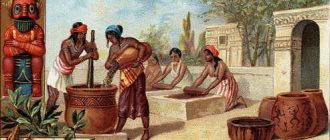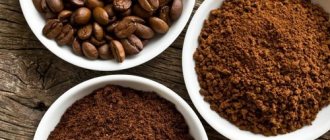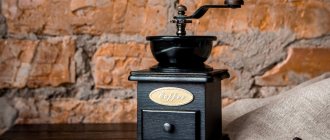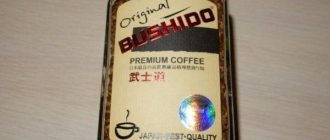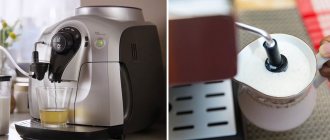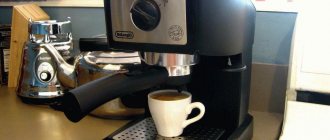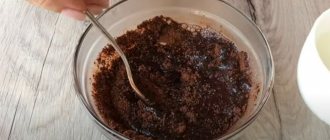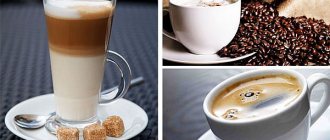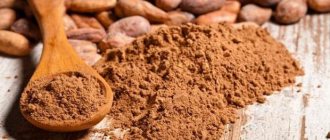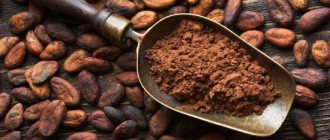Cocoa is a childhood drink. How to cook it to feel that same taste again and share it with your children? One classic recipe, several tricks and modern versions of the drink are in this article.
The recipe for classic cocoa is simple:
- 1 tbsp. l. cocoa powder
- 1 tbsp. l. Sahara
- 2 tbsp. l. hot water
- 200 ml milk
Classic mistakes in preparation are pouring all the liquid into the dry powder at once, or even pouring it onto the surface in a floating mound. Instead of a charming drink, you get milk with chocolate lumps.
Cocoa powder is very fine, essentially dust, so making the drink homogeneous is not so easy. The presence of fat in milk prevents the grains from getting wet and complicates the fight against lumps, so in the classic recipe the powder is mixed with a small amount of water to form a liquid paste.
Sugar is added to the powder before adding water. Thanks to the grains, it helps to rub out lumps, so it is more convenient to use than, for example, honey or syrup. The ratio of sugar and cocoa is 50/50, since the powder has a pronounced bitter taste, which has to be softened with a large amount of sweetness. Dark chocolate lovers can reduce the amount of sugar and add a pinch of salt to enhance the flavor.
An important point: cocoa cannot be boiled. In this case, the drink may acquire an unpleasant bitterness, so it is better to cook it over medium heat and remove it as soon as it begins to gurgle and bubble. For the same reason, it needs to be stirred all the time. Grains of powder are heavier than water and milk; if left alone, they will settle to the bottom and immediately begin to burn and become bitter. We'll have to tinker!
Before serving, you can whip the drink to create a velvety foam, or crumble cold butter or cocoa butter onto the surface of the drink to prevent a film from forming as it cools.
So, let’s summarize the three main rules that should be followed when preparing cocoa:
- First dissolve, then add the entire volume
- Stir all the time
- Do not boil
The rest is a matter of technique and taste.
Times change, but the Golden Label remains the same
Favorite “Golden Label” is cocoa, which is well known to many generations of Russians. Preparing it is not as simple as tea or coffee, but the effort spent will be rewarded with the satisfied smiles of your household. How to brew cocoa correctly is written on its packaging. The most delicious drink is obtained only if it is 100% cocoa bean powder. The “Golden Label”, the composition of which was approved back in Soviet times, has not yet changed and includes only cocoa powder and vanillin, there are no artificial additives. Reviews about this brand are always only positive and even enthusiastic.
Times change…
But the “Golden Label” remains the same.
Still the same color “from light brown to dark brown”, as required by GOST (and it is still strict).
The same green box with such a recognizable design. No, not quite like that: a window has appeared through which the branded packaging foil can be seen (to protect against counterfeits, of which, unfortunately, the current Russian market is “rich”). And most importantly - the same unique aroma and taste, “peculiar to cocoa powder, without third-party tastes and odors” (and again GOST 108, which has changed very little since the times of the USSR). The most famous Russian is true to traditions.
We hope that this article was useful to you, we will be grateful if you share it with your friends on social media. networks. Have a nice day and see you again!
Traditional cooking method
How to prepare your favorite drink? For one serving, a glass of milk, one to two teaspoons of Golden Label cocoa and two to three teaspoons of sugar are enough. During the preparation process, you need to taste the drink. Before the cocoa boils, you can add sugar if it is not sweet, or milk if it is too strong. It is very important to strictly follow the technological process:
- In a large metal saucepan with a round bottom and a long handle, grind Golden Label cocoa with granulated sugar;
- Gradually, stirring continuously, pour in a quarter glass of hot milk;
- grind sugar, cocoa and milk to a smooth paste;
- add the remaining hot milk in the same way;
- bring to a boil and turn off.
According to connoisseurs, it is most pleasant to drink cocoa from a large ceramic mug. It keeps the drink hot longer.
Taste of childhood
For the first time, Zolotoy Yarlyk cocoa appeared in the Mosselprom price list only at the beginning of the 20th century, but even then it acquired a wide audience of fans. This is almost the only factory of that time that produced powder made from natural cocoa beans. This is probably why cocoa with this name remains the most popular brand to this day. How to brew Golden Label cocoa with milk? Our recipe will help you.
Compound:
- 0.5 l of milk;
- 1 tbsp. l. cocoa;
- 1 tbsp. l. Sahara;
- 2 drops vanilla extract;
- spices - optional.
Preparation:
- Take a thick-bottomed pan with a volume of about 1 liter, pour milk into it and place it on the stove.
- Over medium heat, stirring occasionally, bring the milk to a boil and immediately turn the burner to low so that it does not run away.
- Once the milk has boiled, it's time to add cocoa powder to it, but first you need to mix it with sugar.
- Add cocoa and immediately stir thoroughly so that the ingredients are evenly dissolved in the liquid and do not gather in unpleasant lumps on the surface of the milk.
- Cook the cocoa over low heat for about 2-3 minutes, and then add a few drops of vanilla extract to it. And if you like spices, such as cloves or cinnamon, then add them too.
- Let the drink boil for about 3 minutes, remove from heat and cover with a lid.
Cocoa without milk
What if you really want to taste a chocolate drink, but you are not allowed to drink milk? “Golden Label” cocoa powder, the composition of which has never been burdened with extraneous additives, allows you to brew a drink that is allowed for consumption during Orthodox fasts. For it, rice water is used instead of milk.
- Pour 10 g of rice into 300 ml of water and cook. Drain the cereal in a colander and use the broth for a drink.
- Grind 5 g of cocoa and 10 g of sugar in a metal saucepan, add a little broth and stir well to a paste.
- Pour in the remaining broth, stirring the mixture until completely homogeneous. Bring to a boil.
Purpose and use:
Cocoa powder is intended for the preparation of cocoa drinks, as well as for use in the production of various confectionery products. Supplied in a cardboard box weighing 100 grams. The dry mixture has the form of a powder that easily dissolves in hot milk.
Ingredients: cocoa powder, vanilla flavoring.
Nutritional value of 100g of product, g: proteins - 24.0; fats - 15.0; carbohydrates - 10.0; dietary fiber - 35.3; organic acids - 3.9
Energy value - 1470 kJ (350 kcal)/100 g.
Hot mocha with chocolate
“Golden Label” is the highest grade cocoa. The finest grinding makes it possible to experiment with different ingredients. The given recipe is designed for a large company - about eight people.
- In a large metal saucepan, combine cocoa (1 cup), granulated sugar (1 cup), dry instant coffee powder (quarter cup), vanilla (1 packet) and a pinch of salt.
- Bring to a homogeneous paste by pouring hot water (1 cup) in small portions.
- Place on the fire and, stirring constantly, pour in hot milk (6 cups) and cream (2 cups).
- Bring to a boil and pour into mugs.
Coffee with chocolate
- Take a metal saucepan that can hold at least three cups of liquid. Dissolve in it three tablespoons of sugar, the same amount of cocoa powder and three teaspoons of ground coffee with one glass of water. Bring to a boil.
- Separately, boil three glasses of hot milk with 1% fat content. Carefully, stirring constantly, pour it into the saucepan and heat over medium heat, stirring constantly.
- Add vanilla. No need to boil.
- Pour into glasses and garnish with whipped cream.
Cocoa with marshmallows
You will have to tinker with this wonderful delicacy.
- Soak 25 g of gelatin in half a glass of boiled water for 15-20 minutes.
- Separately, in a small saucepan, cook a syrup from 1.5 cups of sugar, corn syrup and a pinch of salt.
- When the sugar has dissolved, turn up the heat and bring the syrup to a slightly caramel state: boil for 8 minutes, no more.
- Now you need to pour the caramel syrup into the dissolved gelatin, whisking with a mixer at low speed. Increase the speed gradually. The mass should become thick and homogeneous. It will take about 15 minutes to beat. At the very end, add vanillin to the mixture.
- Cover a baking sheet with foil or Teflon paper, sprinkle thickly with powdered sugar and place the marshmallow blank into it. Flatten with a silicone spatula, sprinkle with powdered sugar and leave to set at room temperature overnight.
- The next day, remove the marshmallows from the baking sheet directly with the paper, cut into square pieces and roll in powdered sugar.
- Brew classic cocoa: take sugar, milk and Golden Label cocoa powder. The composition of the drink, as you can see, is traditional. Nothing additional is needed. Prepare cocoa according to the instructions on the box. You can use the recipe at the beginning of this article.
- Place chopped dark confectionery chocolate at the bottom of a large glass and pour cocoa drink onto it. Leave room to decorate with whipped cream foam. Place marshmallows on top and lightly sprinkle with grated chocolate.
This dessert is served hot so that the chocolate at the bottom melts.
Beneficial features
In the Soviet Union, it was believed that the “Golden Label” was cocoa for children or people with poor health. Therefore, it was included in the mandatory diet in kindergartens, schools, pioneer camps and sanatoriums. This is not surprising, because cocoa contains B vitamins (B1, B2, B3, B6 and B9), vitamins A, PP and E. It is a source of easily digestible iron, potassium, magnesium, calcium, phosphorus, sulfur, sodium, chlorine , molybdenum, manganese, copper, fluorine and zinc.
Currently, retail chains widely offer numerous options for cocoa drinks, which contain sugar, milk powder, flavorings, taste improvers, preservatives, stabilizers and other additives. This greatly reduces the value of cocoa, because for better solubility, cocoa powder is treated with ammonium carbonate, potash or baking soda, that is, it is prepared. This improves the taste of the drink and makes it easily soluble, but in return many of the healing properties of the product are lost. Preparing such a drink takes a couple of minutes, and “Golden Label” is unprepared cocoa, that is, the beans have been crushed but not treated with any reagents. Anyone who has brewed cocoa knows that it tends to settle and cannot be mixed with milk without first grinding it with sugar.
Consumer Reviews
With the widespread and, one might say, aggressive, introduction of instant “fast food” products, “Golden Label” cocoa remains a natural product. According to consumer reviews, the cocoa from the Red October factory can be considered our national pride. And although you need to tinker with the preparation, the result is worth it. People note that Golden Label cocoa powder is real and natural. It has a pronounced chocolate taste. Consumers use it to prepare not only aromatic drinks, but also all kinds of desserts.
Golden cocoa powder
Perhaps no drink has such a past as Golden Label cocoa powder. The October Revolution, wars, stagnation, perestroika - history changed and was rewritten, and only the taste of the “Golden Label” remained unchanged.
Drank a cup - and into the harem
It is known that in 1100 BC, the peoples of Central America used the pulp of cocoa beans to make an intoxicating drink. Over time, through practical observations, the Indians discovered another, no less pleasant property in these fruits - cocoa increased potency. According to legend, the Aztec leader Montezuma drank a cup of hot cocoa before entering his harem. He had about 600 wives! There is something to envy.
As you know, the course of life of the Indians was disrupted by Columbus, who landed on the shores of America in 1492. He discovered a new continent, and at the same time gave Europeans a lot of new and very tasty things. He also delivered cocoa beans home to Spain. True, the Spanish nobility for a long time could not get used to the strange taste: Columbus brought the fruit, but not the recipe. They were simply ground into powder and water was added. The drink acquired a different taste only when they thought of adding sugar to it and boiling it. Cocoa quickly became popular among the Spanish “oligarchs” of that time; its recipe, of course, was strictly classified.
This continued until the 17th century, when the French king Louis XIII married the Spanish infanta Anna of Austria. As you know, there should be no secrets between husband and wife, even state secrets. After Anna's confession, the cocoa drink began its march across the European continent. Cocoa fruits began to be sold in pharmacies as a means to strengthen memory. Drinking houses appeared in England, where anyone with enough money could discuss the current political and economic situation over a cup of hot cocoa.
Despite the European cocoa boom, in Russia this drink was available only to a select few. And it remained so until 1903, when the Einem Partnership confectionery factory began producing cocoa under the Golden Label brand. The event was truly historic - newspapers vied with each other about the new chocolate product. They said about it: “Einem cocoa is incomparable.”
Mandelstam's favorite chocolate
Creative people, in modern terms, worked at the Einem Partnership. Their ideas were delicious, invariably delighting customers. For example, New Year trees were decorated with Einema marzipan sweets in the shape of animals. Among the factory products was a cake with the intriguing name “Love Me.” It cost differently, depending on the weight. Sometimes buyers made young saleswomen blush when they asked: “Love me” for three rubles, please.”
The factory also worked hard on the first packaging of the “Golden Label”: cocoa was packaged in dark purple boxes and cans, the name was written in gold letters. It is not surprising that the elegantly designed product quickly found its way to the court, or rather, to the kitchens of Russian aristocrats and creative intelligentsia. The poet Irina Odoevtseva, for example, recalled Mandelstam: “He tells how one spring morning he was dying for eggnog. He went to the market and bought an egg from a merchant. But along the way they sold Zolotoy Label chocolate, Mandelstam’s favorite chocolate. Seeing the chocolate, Mandelstam forgot about the eggnog, he “crashed” for chocolate.”
After the revolution, the Einem Partnership factory was nationalized, and in 1922 it received the name Red October. But cocoa production did not stop; moreover, the drink became popular. Numerous advertising posters encouraged people to buy it - before the war they hung in many Soviet grocery stores, although the buyer knew what he was paying for even without advertising.
He just didn’t know how exactly cocoa was born. First, in the Amazon Valley, the fruits are removed from the cocoa trees. This happens twice a year - from April to June and from October to January. So right now the harvest is in full swing in Central America. After drying on plantations, cocoa beans end up in confectionery factories around the world, including Red October. In some bunkers they are crushed, in others they are crushed into powder. After this, dry thoroughly. Then the fun begins: the resulting powder is placed in a special container, where it is picked up by a strong air flow. Small particles are taken into a special container, large particles remain in the container - they are then ground to the desired size. To get “that same” color, the almost finished powder is kept for several hours at a certain temperature, then packed into boxes. The smell in the Red October workshops is such that the Aztec tribes would probably be happy to set up their camps there.
Tastes better with milk
Cocoa is not just tasty. A few sips of a hot drink in the morning will relieve the feeling of hunger at least until lunch and give you strength. The Red October factory sent the “Golden Label” to the front during the Great Patriotic War and produced it for the rear.
The healing properties of cocoa can be listed endlessly. It contains substances that reduce blood pressure, prevent blood clots from forming and the body from aging. American scientists assure that a passion for cocoa will not lead to obesity. German - that the substance cocohil contained in the drink heals wounds and smoothes out wrinkles. The Dutch say that cocoa lovers are less likely to suffer from heart disease. It is not surprising that Vladimir Mayakovsky, in advertising poems for Mosselprom (the food trust of the Moscow Council of National Economy), called for drinking the “Golden Label”.
But we, even without scientists and poets, know how good it is to drink cocoa. Especially during exams and sessions. A few sips - and your head becomes clearer, complex formulas and historical dates are remembered. But just taking hot water and pouring cocoa powder is a criminal rush. You need to know how to prepare it: first mix the powder with sugar, then add water and carefully cook in a pot over low heat, stirring gently and watching how the aromatic foam grows. And at the end you definitely need to add milk. And you will be happy.
In 1960, Red October artist Mikhail Gubonin came up with a new, more strict packaging for cocoa - a dark green box with the name “Golden Label” and, as they would say today, the factory logo. From the moment they entered the store, customers noticed whether there was cocoa on the shelves. In 1968, the powder began to be packaged in boxes depicting a happy boy with a glass in his hand. But he was unable to please cocoa lovers, and two years later the factory returned to its usual green color.
This is what a pack of “Golden Label” cocoa looks like now. True, now the manufacturer has to protect itself from “confectionery pirates” - they shamelessly pour powder into similar packaging that cannot be called cocoa under any circumstances. A real “Golden Label” has a small window on the side through which the foil with a barcode and the factory logo is visible. Only in this package you will find the same cocoa that has gone through many upheavals, but remains the same, from childhood.
Valery Sergeev.
